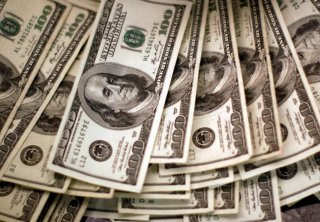The Insane Stimulus Check Problem No One Wants to Admit To
The U.S. Treasury will have to beg, borrow, and steal in order to afford the massive stimulus they've promised the American people.
Here's What You Need to Remember: This amount of borrowing, following similar policy for stimulus during the final year of the Trump Administration, represents a far cry from the Obama years, when the administration and Congress often feuded bitterly over deficits and debts, with the Republican Congress on one occasion using the debt ceiling to extract spending cuts from the Democratic administration.
The $1,400 stimulus checks, much like the rest of the American Rescue Plan from which they emerged, were paid for not by raising taxes or some other type of revenue, but rather through deficit spending. And according to a new report, that’s led to a huge amount of borrowing by the government.
According to Bloomberg News, which cited government-issued figures, the U.S. Treasury has quadrupled its borrowing estimate for the quarter, through June, in order to pay for the pandemic-era spending. The Treasury expects to need $1.3 trillion over the second half of the fiscal year to pay for the spending.
Per the report, Treasury expects to borrow $463 billion between April and June, followed by $821 billion for the three months ending in September.
“The Treasury has been steadily working down its cash balance from a record level last year, after accumulating that extra firepower to give itself the flexibility to deal with any pandemic-related spending contingencies,” Bloomberg said.
Those figures are, however, merely projections.
“These projections are difficult to rely on,” Jefferies analysts Thomas Simons and Aneta Markowska said in a note quoted by Bloomberg. “There is a significant amount of risk surrounding the size and pacing of tax receipts during the quarter and outlays related to the stimulus as well. These projections should be viewed in the context that the outlook for financing changes on a daily basis.”
MarketWatch, citing Treasury figures, reported that in April, the federal budget deficit had jumped to $660 billion, following the passage of the stimulus. This was a doubling of the deficit from the previous month, before the package of the American Rescue Plan, and was the third-highest monthly deficit in recorded history. The annualized deficit at the end of 2020 was $3 trillion, also a new record. MarketWatch also said that the government is likely to continue to run large deficits for several more years.
Tax revenues, meanwhile, jumped to $267.6 billion in March, a big increase over the previous month, which was seen as an indication of an improving economic picture.
This amount of borrowing, following similar policy for stimulus during the final year of the Trump Administration, represents a far cry from the Obama years, when the administration and Congress often feuded bitterly over deficits and debts, with the Republican Congress on one occasion using the debt ceiling to extract spending cuts from the Democratic administration.
“A majority of Wall Street dealers predict the Treasury will keep note and bond auction sizes unchanged for the second straight quarter. Yet most also foresee the Treasury sometime later this year beginning to whittle down coupon-bearing debt auctions, given that funding needs are peaking,” Bloomberg said.
Stephen Silver is a technology and news writer for the National Interest. This article first appeared earlier and is being reposted due to reader interest. Image: Reuters

